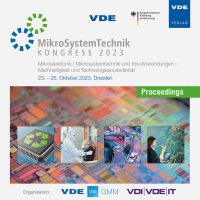Electric-Field-Assisted Printing Technology for Enhanced Patterning of Micro- and Nanostructures
Konferenz: MikroSystemTechnik Kongress 2023 - Kongress
23.10.2023-25.10.2023 in Dresden, Deutschland
Tagungsband: MikroSystemTechnik Kongress 2023
Seiten: 6Sprache: EnglischTyp: PDF
Autoren:
Philippin, Nadine (Faculty Engineering and Business, Heilbronn University of Applied Sciences, Germany & TUM School of Computation, Information and Technology, Chair of Physics of Electrotechnology, Technical University of Munich, Germany)
Kuehne, Ingo (Faculty Engineering and Business, Heilbronn University of Applied Sciences, Germany)
Schrag, Gabriele (TUM School of Computation, Information and Technology, Chair of Physics of Electrotechnology, Technical University of Munich, Germany)
Inhalt:
Micro- and nanostructures are crucial parts of diverse printed electronic and sensor devices. Unique physical properties such as their high sensitivity or a large surface-to-volume ratio enable various new product paradigms, particularly in the field of medical engineering. Compared to subtractive fabrication techniques, additive routes entail major advantages. Contrary to photolithographical approaches, a cost-efficient, maskless and customized patterning of precise 2D and 3D structures is feasible. Furthermore, additive technologies are compatible with a wide range of conductive, dielectric and insulating ink materials and enable the use of rigid, flexible and biocompatible substrates. These attributes are especially beneficial for the fabrication of wearables for health monitoring. However, conventional printing methods like inkjet printing are still limited in their writing resolution. To overcome this drawback, the present work focusses on the so-called electrohydrodynamic (EHD) printing technology. This novel high-resolution method is a direct-writing, non-contact as well as maskless process which is based on an electrohydrodynamically induced fluid flow. The achievable printing resolution exceeds other additive approaches by at least two orders of magnitude. Three major aspects are discussed within this work consisting of the development of a Finite-Element-Method (FEM) model which is based on the so-called Taylor–Melcher leaky dielectric model for analysis of continuous jet EHD printing and an investigation of cone formation considering specific material parameters. In this way, the electric-field-assisted deformation of a hemispherical liquid meniscus into a conical shape and the generation of a continuous jet for different fluids could be observed. Simulations were also utilized to understand the influence of relevant process parameters on the jetting behavior (e.g. stand-off-height, applied voltage) and they could be validated by experimental results. The second emphasis was an experimental evidence of various jetting modes in DC-based EHD printing. The experiments were realized by means of an appropriate EHD printing setup at laboratory scale. Finally, a metrological characterization to demonstrate the correlation between the applied voltage and a resulting jet diameter was carried out, whereby a minimum jet diameter of 9micrometer could be observed.


